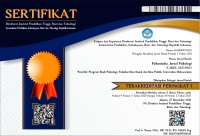Dynamics of Romantic Relationship Satisfaction in Long Distance Relationships: A Psychological Perspective
Abstract
Individu yang menjalani hubungan jarak jauh (LDR) memiliki banyak tantangan untuk mempertahankan hubungannya. Banyak yang mengakui sulit menjalaninya hingga mempertanyakan kepastian hubungannya. Namun banyak juga yang berhasil dalam menjalani hubungan jarak jauh. Faktanya, meskipun pasangan LDR jarang melakukan kontak secara langsung, mereka juga memiliki tingkat kepuasan relasi romantis yang sama dengan mereka yang berada dalam hubungan yang dekat secara geografis. Penelitian ini bertujuan untuk mengeksplorasi terkait gambaran kepuasan relasi romantis pada individu yang menjalani long distance relationship. Metode yang digunakan adalah literature review berdasarkan kajian literatur publikasi-publikasi sebelumnya mengenai kepuasan relasi romantis pada individu yang menjalani long distance relationship. Penelitian ini kemudian menunjukkan bahwa dalam mencapai kepuasan hubungan dalam pasangan LDR yaitu dengan memanfaatkan bantuan teknologi untuk berkomunikasi yang selanjutnya digunakan untuk pengungkapan diri demi terbentuknya kepercayaan dan meminimalisir ketidakpastian dalam hubungan. Kepuasan relasi romantis juga berdampak pada kesehatan individu.
Keywords
Full Text:
FULL TEXTReferences
Adamczyk, K. (2017). Going beyond relationship status: A cross-sectional and longitudinal investigation of the role of satisfaction with relationship status in predicting polish young adults mental health. Journal of Social and Clinical Psychology, 36(4), 265–284. https://doi.org/10.1521/jscp.2017.36.4.265
Belus, J. M., Pentel, K. Z., Cohen, M. J., Fischer, M. S., & Baucom, D. H. (2019). Staying Connected: An Examination of Relationship Maintenance Behaviors in Long-Distance Relationships. Marriage and Family Review, 55(1), 78–98. https://doi.org/10.1080/01494929.2018.1458004
Billedo, C. J., Kerkhof, P., & Finkenauer, C. (2020). Facebook intensity, social network support, stability and satisfaction in long-distance and geographically-close romantic relationships: A test of a mediation model. Cyberpsychology, 14(2). https://doi.org/10.5817/CP2020-2-5
Cepukiene, V. (2019). Does relationship satisfaction always mean satisfaction? Development of the couple relationship satisfaction scale. Journal of Relationships Research, 10. https://doi.org/10.1017/jrr.2019.12
Chrisnatalia, M., & Ramadhan, F. A. E. (2022). Kepuasan Hubungan Romantis Pada Wanita Dewasa Awal Yang Menjalin Hubungan Pacaran Jarak Jauh (Studi Deskriptif). Jurnal Psikologi : Media Ilmiah Psikologi, 20(2), 1–7. https://doi.org/10.47007/jpsi.v20i2.266
Du Bois, S. N., Woodward, H., Manser, K., Saigal, S., Santic, F., Tully, T., & Sher, T. G. (2022). Examining Relationship-Level Predictors of Individual-Level Health in Long Distance Relationships. Family Journal, 30(3), 289–300. https://doi.org/10.1177/10664807211054151
Fataraya, D. (2018). Pengelolaan Hubungan Antarpribadi Pada Pasangan Berpacaran. E-Journal Undip, 6(3), 35–44. https://ejournal3.undip.ac.id/ind ex.php/interaksionline/article/vie w/20869&ved=2ahUKEwjKy4v f5PtAhWUIbcAHQiODelQFjA AegQIAxAC&usg=AOvVaw2F%0A %0ATpEfNQyRIrRjbj- sLMqt&cshid=1605950708822%0A
Firmin, M. W., Firmin, R. L., & Merical, K. L. (2013). Extended Communication Efforts Involved With College Long-Distance Relationships. Contemporary Issues in Education Research (CIER), 6(1), 97. https://doi.org/10.19030/cier.v6i1.7608
Guldner, G. T., & Swensen, C. H. (1995). Time spent together and relationship quality: Long-distance relationships as a test case. Journal of Social and Personal Relationships, 12(2), 313–320. https://doi.org/10.1177/0265407595122010
Guzmán-González, M., Gómez, F., Bahamondes, J., Barrientos, J., Garrido-Rojas, L., Espinoza-Tapia, R., & Casu, G. (2023). Internalized homonegativity moderates the association between attachment avoidance and emotional intimacy among same-sex male couples. Frontiers in Psychology, 14(March), 1–12. https://doi.org/10.3389/fpsyg.2023.1148005
Hammonds, J. R., Ribarsky, E., & Soares, G. (2020). Attached and Apart: Attachment Styles and Self-Disclosure in Long-Distance Romantic Relationships. Journal of Relationships Research, 11. https://doi.org/10.1017/jrr.2020.10
Hampton, A. J., Rawlings, J., Treger, S., & Sprecher, S. (2017). Channels of computer-mediated communication and satisfaction in long-distance relationships. Interpersona, 11(2), 171–187. https://doi.org/10.5964/ijpr.v11i2.273
Holtzman, S., Kushlev, K., Wozny, A., & Godard, R. (2021). Long-distance texting: Text messaging is linked with higher relationship satisfaction in long-distance relationships. Journal of Social and Personal Relationships, 38(12), 3543–3565. https://doi.org/10.1177/02654075211043296
Joshi, A. (2021). Does The Physical Distance Between Couples Increase Trust and Overall Satisfaction? A Comparative Study Between Long-Distance Romantic Relationships and Geographically Close Relationships. International Journal of Indian Psychology, 9(3), 1520-1529. https://doi.org/10.25215/0903.141
Kansky, J., Allen, J. P., & Diener, E. (2019). The young adult love lives of happy teenagers: The role of adolescent affect in adult romantic relationship functioning. Journal of Research in Personality, 80, 1–9. https://doi.org/10.1016/j.jrp.2019.03.006
Khaddouma, A., Shorey, R. C., Brasfield, H., Febres, J., Zapor, H., Elmquist, J., & Stuart, G. L. (2016). Drinking and dating: Examining the link among relationship satisfaction, hazardous drinking, and readiness-to-change in college dating relationships. Journal of College Student Development, 57(1), 32–46. https://doi.org/10.1353/csd.2016.0007
Marsha, N. A., & Indrijati, H. (2012). Pengaruh Gaya Kelekatan Dewasa terhadap Kepuasan Hubungan Dewasa Awal yang Menjalani Pacaran Jarak Jauh. Buletin Riset Psikologi Dan Kesehatan Mental, X, 1–9.
Morey, J. N., Gentzler, A. L., Creasy, B., Oberhauser, A. M., & Westerman, D. (2013). Young adults’ use of communication technology within their romantic relationships and associations with attachment style. Computers in Human Behavior, 29(4), 1771–1778. https://doi.org/10.1016/j.chb.2013.02.019
Pistole, M. C., & Roberts, A. (2011). Measuring long-distance romantic relationships: A validity study. Measurement and Evaluation in Counseling and Development, 44(2), 63–76. https://doi.org/10.1177/0748175611400288
Rifayanti, R., & Diana, D. (2019). Pengaruh Gaya Resolusi Konflik dan Penyesuaian Perkawinan Dengan Kebahagiaan Pada Pasangan Suami Istri yang Menjalani Hubungan Jarak Jauh. Psikostudia : Jurnal Psikologi, 8(1), 37. https://doi.org/10.30872/psikostudia.v8i1.2385
Roberts, A., & Carole Pistole, M. (2009). Long-distance and proximal romantic relationship satisfaction: attachment and closeness predictors. Journal of College Counseling, 12(1), 5–17. https://doi.org/10.1002/j.2161-1882.2009.tb00036.x
Robles, T. F. (2014). Marital Quality and Health: Implications for Marriage in the 21st Century. Current Directions in Psychological Science, 23(6), 427–432. https://doi.org/10.1177/0963721414549043
Rusbult, C. E., Martz, J. M., & Agnew, C. R. (1998). The Investment Model Scale: Measuring commitment level, satisfaction level, quality of alternatives, and investment size. Personal Relationships, 5(4), 357–387. https://doi.org/10.1111/j.1475-6811.1998.tb00177.x
Stafford, L., & Merolla, A. J. (2007). Idealization, reunions, and stability in long-distance dating relationships. Journal of Social and Personal Relationships, 24(1), 37–54. https://doi.org/10.1177/0265407507072578
Stewart, M. C., Dainton, M., & Goodboy, A. K. (2014). Maintaining Relationships on Facebook: Associations with Uncertainty, Jealousy, and Satisfaction. Communication Reports, 27(1), 13–26. https://doi.org/10.1080/08934215.2013.845675
Taylor, S. E., Peplau, L. A., & Sears, D. O. (2009). Social psychology (12th ed.) Pearson Education Group, Inc.
Tunisa, S.F. A., & Damaiyanti, M. (2021). Hubungan antara Kepuasan dalam Pacaran dengan Perilaku Kekerasan dalam Pacaran pada Remaja di Kota Samarinda. Borneo Student Research, 2(2). https://journals.umkt.ac.id/index.php/bsr/article/view/1524
Utz, S., Muscanell, N., & Khalid, C. (2015). Snapchat Elicits More Jealousy than Facebook: A Comparison of Snapchat and Facebook Use. Cyberpsychology, Behavior, and Social Networking, 18(3), 141–146. https://doi.org/10.1089/cyber.2014.0479
常小娜. (2023). Communication Posture and Long-Distance Romantic Relationship Satisfaction: The Intermediary of Positive Psychological Capital. Advances in Social Sciences, 12(05), 2209–2216. https://doi.org/10.12677/ass.2023.125299
DOI: http://dx.doi.org/10.30872/psikostudia.v14i2.18644
Refbacks
- There are currently no refbacks.
Copyright (c) 2025 Evanjelina Agracia Tumi Geong, Endang Wedyorini

This work is licensed under a Creative Commons Attribution-ShareAlike 4.0 International License.
Psikostudia: Jurnal Psikologi is indexed by :
PSIKOSTUDIA: Jurnal Psikologi Published by Faculty of Social and Political Siences, University of Mulawarman, Samarinda, East Kalimantan and This work is licensed under a Creative Commons Attribution-ShareAlike 4.0 International License.
_________________________________________
PSIKOSTUDIA: Jurnal Psikologi
Department of Psychology
Faculty of Social and Political Siences, University of Mulawarman
Jl. Muara Muntai Kampus Gn. Kelua Samarinda 75411
Phone: +62 813 35350368
E-Mail: psikostudia@fisip.unmul.ac.id




















